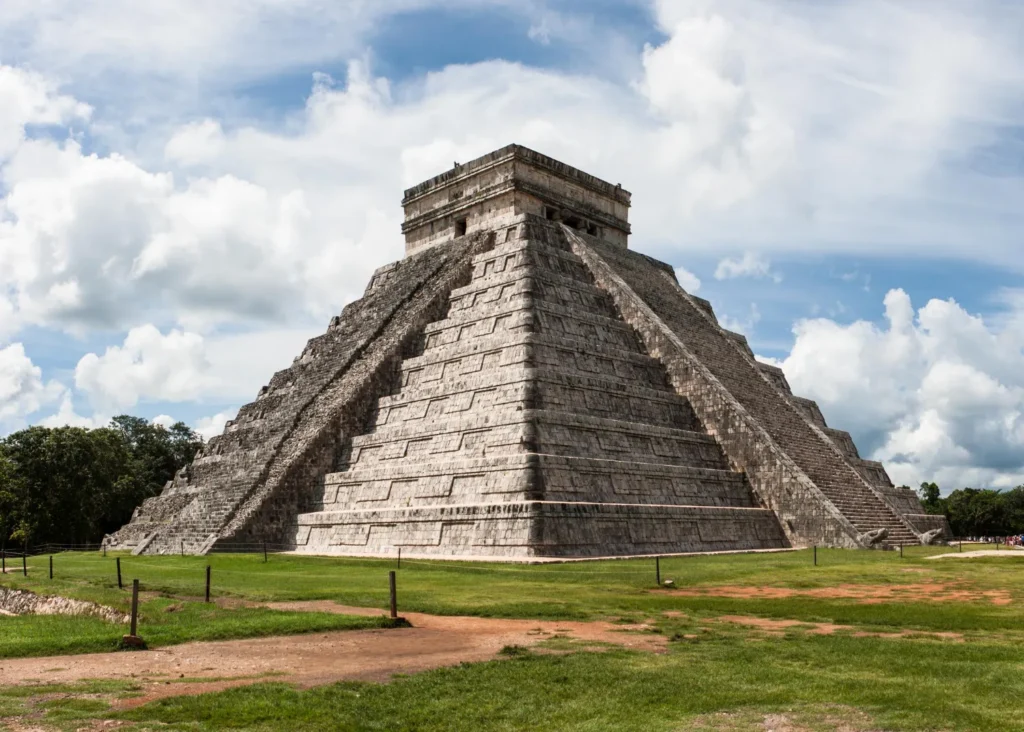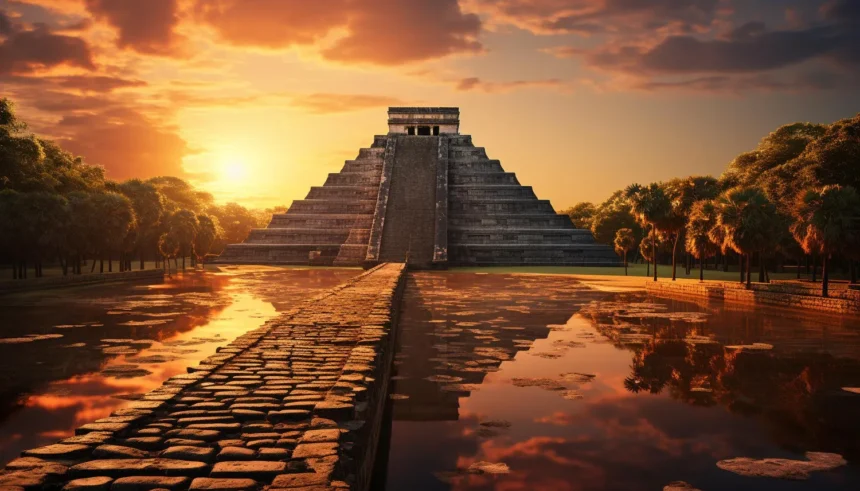Introduction
Have you ever wondered what’s inside the Pyramid of Chichén Itzá? This incredible structure, also known as El Castillo or the Temple of Kukulcán, stands at the heart of Chichén Itzá, one of Mexico’s most renowned Mayan ruins. But what secrets lie within its limestone walls? What makes it a marvel that continues to captivate archaeologists and tourists alike?
With over 2 million visitors annually, El Castillo is more than a symbolic landmark—it’s a gateway to an ancient civilization’s astonishing achievements. Beneath its towering facade, the pyramid conceals hidden chambers, scientific wonders, and untold mysteries.
This article will explore five incredible secrets waiting to be uncovered inside the Pyramid of Chichén Itzá.
Read also: Top 10 Most Popular Cities In The World To Visit In 2025
Historical Background of Chichén Itzá
Before we dive into the details of what’s inside the Pyramid of Chichén Itzá, it’s essential to understand the historical context of this ancient wonder. Chichén Itzá flourished between the 9th and 12th centuries AD, during the height of the Mayan civilization. Located in Mexico’s Yucatán Peninsula, it was once a bustling hub of culture, religion, and commerce.
The pyramid, also known as the Temple of Kukulcán, symbolizes religious devotion and astronomical precision. Each of its four sides contains 91 steps, which, combined with the platform at the top, total 365—the exact number of days in a solar year. This is a testament to the Maya’s sophisticated understanding of astronomy and mathematics.
El Castillo was more than just an impressive architectural feat; it was central to religious rituals, particularly worshiping Kukulcán, the Feathered Serpent god. The pyramid’s design creates a fascinating illusion during the spring and autumn equinoxes, where shadows form the appearance of a serpent slithering down the side of the structure.
Read also: Difference Between a Solstice and an Equinox: 3 Easy Facts to Remember
What’s Inside the Pyramid of Chichén Itzá?
So, what’s inside the Pyramid of Chichén Itzá? As we peel back the layers of El Castillo, we uncover remarkable discoveries that reveal the ingenuity and mystery of the Maya civilization. Here are five secrets you may not know about:
1. A Pyramid Inside a Pyramid
Archaeological excavations have uncovered one of the most intriguing aspects of what’s inside the Pyramid of Chichén Itzá—another pyramid. A second, smaller pyramid, or “substructure,” lies hidden within El Castillo. Discovered in the 1930s, this internal pyramid predated the outer structure for several centuries, showcasing an earlier stage of Mayan architecture.

This “pyramid within a pyramid” phenomenon is not unique to Chichén Itzá; similar designs have been found in other Mayan ruins. However, multiple layers of construction suggest the importance of continuous renovation and religious significance.
Key Features of the Pyramid Layers
| Layer | Age | Key Features |
| Outer Pyramid | 12th century AD | 91 steps on each side, astronomical significance |
| Inner Pyramid | 10th century AD | Smaller structure, earlier Mayan design |
2. Hidden Chambers Deep Within
When we think about what’s inside the Pyramid of Chichén Itzá, hidden chambers might not be the first thing that comes to mind. However, recent discoveries have revealed a network of tunnels and rooms inside the pyramid that may have served various purposes, from burial chambers to sacred spaces for Mayan rituals.
One of the most significant discoveries is a chamber deep within the inner pyramid. Archaeologists believe this could have been a royal burial site or a ceremonial space dedicated to the Feathered Serpent god, Kukulcán. Unfortunately, much of this area remains inaccessible to visitors due to its fragility.
Read also: 24 Astonishing Fun Geography Facts That Will Amaze You!
3. A Cenote Beneath the Pyramid
Among the many mysteries of what’s inside the Pyramid of Chichén Itzá, perhaps one of the most surprising is what lies beneath it—a cenote, or natural sinkhole. Discovered using ground-penetrating radar, this cenote sits directly below the pyramid’s foundation and may have been a significant factor in the pyramid’s location.
Cenotes were sacred places in Mayan culture, believed to be portals to the underworld. Offerings, including human sacrifices, were often made to appease the gods. The cenote beneath El Castillo likely played a vital role in Mayan religious practices, making the pyramid a direct connection between the heavens and the underworld.
Read also: Unveiling the Mystery of Giant Sinkholes: Ancient Forests Hidden in China’s Heavenly Pits
4. The Mysterious Red Jaguar Throne
Another extraordinary discovery inside El Castillo is the Red Jaguar Throne. Located deep within the inner pyramid, this throne is a stunning artifact carved from stone, painted red, and adorned with jade spots. Archaeologists suggest Mayan rulers once used it during ceremonial events, reinforcing the idea that what’s inside the Pyramid of Chichén Itzá holds incredible cultural significance.
This hidden relic provides invaluable insight into the lifestyle of the Mayan elite, offering a glimpse into the world of kings and priests who ruled Chichén Itzá.

5. The Temple of Kukulcán’s Acoustics
The final secret involves the remarkable acoustic phenomena outside and inside the Pyramid of Chichén Itzá. The pyramid’s construction creates a unique echo effect, particularly when someone claps at the base of the staircase. The sound mimics the chirping of the quetzal, a bird sacred to the Maya.
Scientists believe this acoustic effect was intentional, meant to replicate the voice of Kukulcán. While many tourists marvel at the exterior’s soundscape, experts suggest that inside the Pyramid of Chichén Itzá, similar auditory phenomena may have been harnessed during ceremonies, creating a powerful spiritual atmosphere.
The Symbolism and Architecture of El Castillo
Now that we’ve uncovered what’s inside the Pyramid of Chichén Itzá, let’s explore the symbolism of its design. The pyramid is more than a physical structure; it’s a spiritual map. Each of the nine levels of El Castillo represents the Mayan belief in the nine underworld levels, while the 365 steps reflect their deep knowledge of astronomy.

The pyramid’s alignment with celestial events, particularly the equinoxes, reinforces the Maya’s connection to the heavens. The Temple of Kukulcán symbolizes power and the Mayans’ pursuit of harmony with nature and the cosmos.
Read also: Ghost In The Cosmos: The Challenging Discovery of Nube, the Dwarf Galaxy
How to Visit Chichén Itzá and Experience the Pyramid
For those interested in seeing what’s inside the Pyramid of Chichén Itzá firsthand, a trip to Chichén Itzá is a must. While visitors are no longer allowed to climb El Castillo or enter its chambers due to preservation efforts, the surrounding site offers plenty of exploration opportunities.
If you plan to visit, the best time to experience the pyramid’s grandeur is during the spring or autumn equinoxes, when the famous shadow of Kukulcán appears. You can also take guided tours to learn more about the history and symbolism of the Mayan ruins. Nearby, the Sacred Cenote and the Great Ball Court are also worth visiting.
Read also: 10 Landmarks That Should Be Considered Wonders of the World
Conclusion
What’s inside the Pyramid of Chichén Itzá is a captivating blend of history, mystery, and science. From hidden chambers and cenotes to astonishing acoustics and cultural relics, El Castillo continues to reveal the extraordinary achievements of the Mayan civilization. This ancient structure is not just a relic of the past; it’s a testament to the ingenuity and spirituality of one of the world’s most advanced early cultures. We encourage anyone interested in archaeology, history, or ancient civilizations to explore the wonders of Chichén Itzá.
Key Takeaway
The Temple of Kukulcán at Chichén Itzá holds many secrets, including hidden pyramids, chambers, and cultural relics that provide insight into Mayan civilization’s spiritual and astronomical knowledge.
FAQs
1. Can tourists enter inside the Pyramid of Chichén Itzá?
No, tourists are prohibited inside El Castillo due to preservation efforts, but the surrounding areas are accessible.
2. Why is there a cenote beneath the pyramid of Chichén Itzá?
The cenote is a natural sinkhole, considered sacred by the Maya, and likely influenced the pyramid’s construction location.
3. What is the significance of the Red Jaguar Throne?
The Red Jaguar Throne, an important artifact found inside the pyramid, was likely used by Mayan rulers for ceremonial purposes.
4. What is the acoustic phenomenon at Chichén Itzá?
The pyramid’s design creates an echo effect, mimicking the chirping of a sacred bird when a clap is made at the base.

